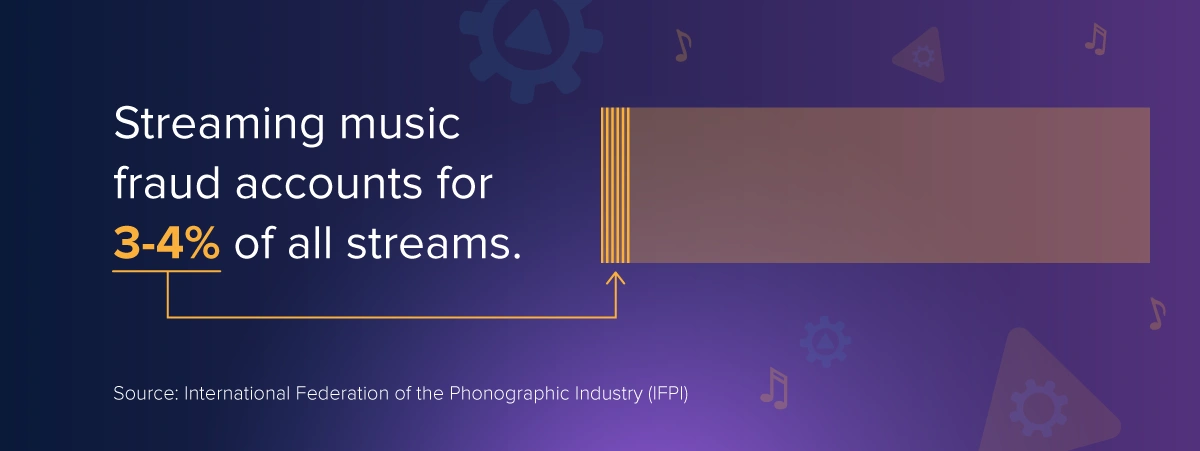
Can data analytics and machine learning protect against the $2B+ music streaming fraud crisis?
Music streaming fraud diverts over $2 billion annually, threatening the digital music ecosystem’s financial integrity by corrupting every decision-making data point.
From artist development to marketing strategies, fraudulent streams create significant damage. They inflate play counts, skew royalty distribution and distort market signals. This dishonest behavior particularly harms emerging artists who are self-publishing and seeking recognition. Fraudulent streams can mislead managers and artists and repertoire (A&R) representatives, causing them to waste resources chasing false leads.
Every strategic decision based on streaming data becomes questionable when fraud enters the equation. Legitimate subscription holders pay the price, as subscription fees tend to increase when streaming services must invest more money to combat fraudulent activities.
Fake streams, real threats
Modern fraudsters employ sophisticated techniques, including bot networks that mimic human listening patterns, complex playlist manipulation schemes and click farms that artificially inflate stream counts. For example, bots can simulate thousands of streams on a track within hours, generating an inflated revenue payout that doesn’t accurately reflect organic listening behavior. Playlist manipulation can also lead to fake engagement, with curators inflating stream counts in exchange for compensation.
These tactics continuously evolve, making fraud detection increasingly challenging. The industry must now rely on advanced analytics and machine learning (ML) to detect suspicious patterns in real time.
3 key challenges in combating fraud
In my opinion, the fight against streaming fraud faces 3 critical hurdles that demand a delicate balance between aggressive detection and maintaining user trust:
- Complex fraud techniques
Detecting fake streams isn’t straightforward. Legitimate viral content can also experience sudden activity spikes, complicating identification. - False positive risks
Incorrectly flagging legitimate streams creates friction between artists, platforms and fans. Balancing detection without alienating users is crucial. - Reputational damage
Ineffective fraud management can erode user trust and industry credibility. Streaming services must demonstrate a commitment to transparency and fairness.
Deploying a digital defense
To build an effective anti-fraud strategy, you should adopt a multi-faceted approach that includes:
- Deploying real-time monitoring systems that flag suspicious activities instantly
- Fostering cross-industry collaboration between platforms, rights organizations and music companies
- Maintaining transparent anti-fraud policies to prevent unintentional violations
- Regularly updating detection algorithms to counter evolving tactics
4 benefits of a data-driven approach
The heart of the fight against streaming fraud lies in advanced data analytics and ML. Benefits include:
- Identifying suspicious behaviors like IP clustering
- Spotting potential fraud networks early
- Ensuring accurate royalty distribution
- Enabling strategic decisions based on genuine consumer behavior
Data analytics can also quantify the precise economic damage of streaming fraud beyond surface-level revenue loss. Charts can quantify a legitimate payout structure for legitimate sound recording owners versus a revenue loss from illegitimate parties.
Tech strikes back
I believe training ML algorithms to spot and consider illegitimate music streams will be a vital growth sector for the music industry. Protecting legitimate copyrighted sound recordings is crucial for record labels and music publishers to maintain their market value against illegitimate and fraudulent music streams.
There are a few occurrences in which ML algorithms can be trained to spot illegitimate streams by considering:
- Song engagement
Generally, fans of a song will wish to click on some other options (view song credits, go to album, go to artist, add to liked songs, etc.). It would be unusual if none of these options had been explored for a high-streaming song.
- Platform
Most of the modern public listens to music streamed on their mobile devices. High streaming originating from a desktop would be a cause for suspicion.
- Ad vs free
Ad-based accounts (free) generate fewer streams than their premium paid accounts. High streaming originating from ad-based accounts would also cause suspicion.
AI-driven analytics can develop real-time fraud detection that minimizes false positives. Third-party companies specializing in AI fraud detection must partner with streaming services to build a real-time platform to analyze, detect and act upon data. Of course, this would be a cat-and-mouse challenge as fraudsters constantly adapt techniques to stay ahead of law enforcement.
AI systems need to be taught and reinforced with constantly updated data to more accurately determine the effects of streaming manipulation.
Fight fraud or face failure
The future of streaming depends on genuine fan engagement, not manipulated metrics. This requires advanced ML capabilities, clear industry-wide policies, collaborative accountability and potential legal and financial deterrents for fraudulent actors.
The challenge isn’t just detecting fraud — it’s creating the necessary investments and collaborations to safeguard the industry’s future. With data analytics as an ally, I believe you can build a more balanced and transparent streaming landscape.
Learn more about protecting artists from music streaming fraud and fake copyrights in the era of AI.
Get the latest news, updates, and exclusive insights from Vistex delivered straight to your inbox. Don’t miss out—opt in now and be the first to know!



